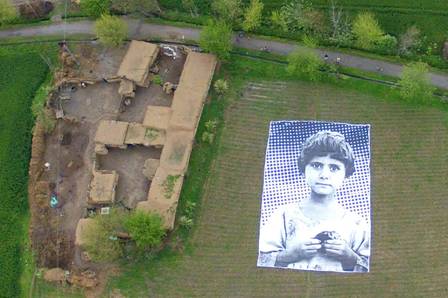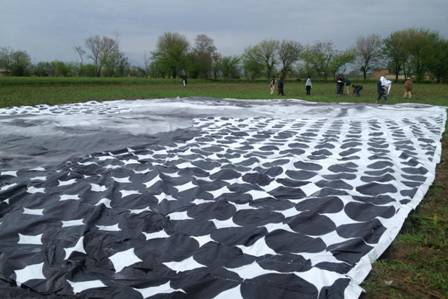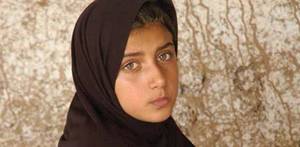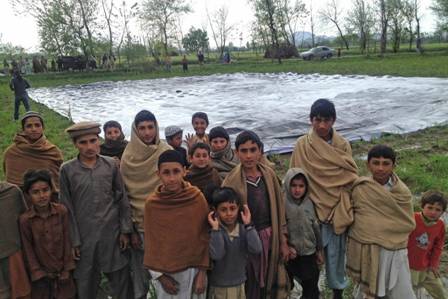Artists Put Human Face To Drone Victims In Pakistan
By Countercurrents
8 April, 2014
Countercurrents.org

The poster seen from above. (Foundation for Fundamental Rights)
Children gather near the installation. (Foundation for Fundamental Rights)

The poster is unfurled in a field in Pakistan 's Khyber Pakhtunkhwa region. (Foundation for Fundamental Rights)
Artists have come forward to give a human face to victims of drone strike in Pakistan. A large poster with face of a child has been made in a Pakistan village.
Drone attack and its victims are sensitive and controversial issues. The drone casualty figures are difficult to ascertain.
Citing Pakistan government and NGO sources Amnesty International in its October 2013 report Will I be Next? said: Between 400 to 900 civilians may have been killed and at least 600 seriously injured, including children, in 330 to 374 strikes since 2004.
In the report, Nabeela, an eight-year old girl, has been quoted: I wasn't scared of drones before, but now when they fly overhead I wonder, will I be next?

Nabeela
The Amnesty report said:
Nabeela is granddaughter of US drone strike victim Mamana Bibi. On a sunny afternoon in October 2012, 68-year-old Mamana Bibi was killed in a drone strike that appears to have been aimed directly at her. Her grandchildren recounted in painful detail to Amnesty International the moment when Mamana Bibi, who was gathering vegetables in the family fields in Ghundi Kala village, northwest Pakistan, was blasted into pieces before their eyes. Nearly a year later, Mamana Bibi's family has yet to receive any acknowledgment that it was the US that killed her, let alone justice or compensation for her death.
The report cited another drone strike incident:
Earlier, on July 6, 2012, 18 male laborers, including at least one boy, were killed in a series of US drone strikes in the remote village of Zowi Sidgi . Missiles first struck a tent in which some men had gathered for an evening meal after a hard day's work, and then struck those who came to help the injured from the first strike. Witnesses described a macabre scene of body parts and blood, panic and terror, as US drones continued to hover overhead.
The human rights organization said:
[T]argeted killings by the USA has fast become one of the most controversial human rights issues in the world. In no place is this more apparent than in Pakistan .
The USA, which refuses to release detailed information about individual strikes, claims that its drone operations are based on reliable intelligence, are extremely accurate, and that the vast majority of people killed in such strikes are members of armed groups such as the Taliban and al-Qa'ida. Critics claim that drone strikes are much less discriminating, have resulted in hundreds of civilian deaths, some of which may amount to extrajudicial executions or war crimes, and foster animosity that increases recruitment into the very groups the USA seeks to eliminate.
The White House has downplayed the number of civilian deaths associated with drone strikes while highlighting the number of militants killed. But those who live in Pakistan 's tribal region say that is subterfuge.
The Amnesty report said:
The US government's utter lack of transparency about its drone program posed a significant research challenge. The USA refuses to make public even basic information about the program, and does not release legal or factual information about specific strikes. None of the US authorities contacted by Amnesty International were willing to provide information regarding the specific cases documented in this report or the legal and policy basis for the drone program in Pakistan . The Central Intelligence Agency (CIA), which is believed to be responsible for the US drone program in Pakistan , said that questions regarding the drone program should be put to the White House. As at time of publication, the White House had not responded to Amnesty International's repeated requests for comment.
The report added:
Apart from Pakistan , other states, including Australia , Germany and the UK , appear to be providing intelligence and other assistance to the USA in carrying out drone strikes.
It said:
In tackling threats from armed groups in the Tribal Areas, Pakistan, the USA and other states providing assistance must act in full conformity with their obligations under international human rights law and, where applicable, international humanitarian law. Secrecy, technology and an elastic interpretation of law and policy may have given the USA unrivalled access to one of the most remote and lawless parts of the world. But immediate security concerns, whether real or perceived, must not and cannot be addressed by trampling on the rights of people living in Pakistan 's tribal areas.
Dylan Stableford reported in Yahoo News (http://news.yahoo.com/girl-pakistan-drone-installation-not-a-bug-splat-140003715.html):
In an attempt to put a face on civilian victims of US drone strikes, a group of artists has installed a massive portrait of a girl facing up from a field in Pakistan .
The poster, measuring 90 by 60 feet and made of vinyl, was unrolled with the help of locals two weeks ago in a village in the Khyber Pakhtunkhwa region in northwest Pakistan, where residents say attacks by the pilotless aircraft are a part of daily life.
"Although there is awareness for drone attacks, it's rarely humanized," a representative for the artist collective wrote in an email to Yahoo News. "This installation is our attempt at showing that."
According to the group, the project "was inspired after learning that drone operators refer to kills as bug splats,'" since "viewing the body through a grainy video image gives the sense of an insect being crushed," says a post on the project's website, NotaBugSplat.com. "Now, when viewed by a drone camera, what an operator sees on his screen is not an anonymous dot on the landscape, but an innocent child victim's face."
The unidentified child in the poster "lost both her parents and two young siblings in a drone attack," the website says.
The installation was designed to be captured by satellites, however, "We don't know if it is still there or not," the representative wrote in an email. The villagers were encouraged to "use the fabric for roofing and other useful purposes. The art was always meant to be utilized and not discarded after it was photographed."
The collective declined to reveal the identity of its members comprised of artists from the United States , France and Pakistan out of concern for their safety.
"Some of our team members are in Pakistan and we want to be sensitive to their safety over the next couple of days," the representative wrote. "This area is pretty dangerous."
Comments are moderated

